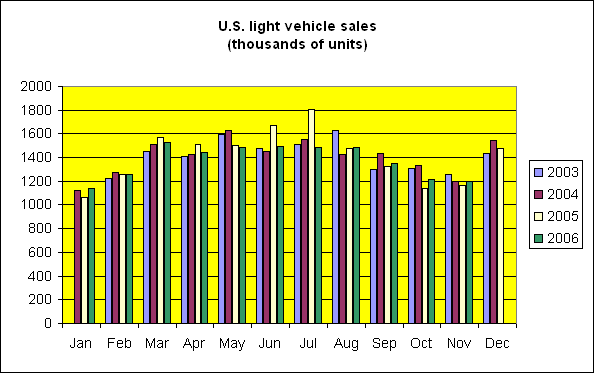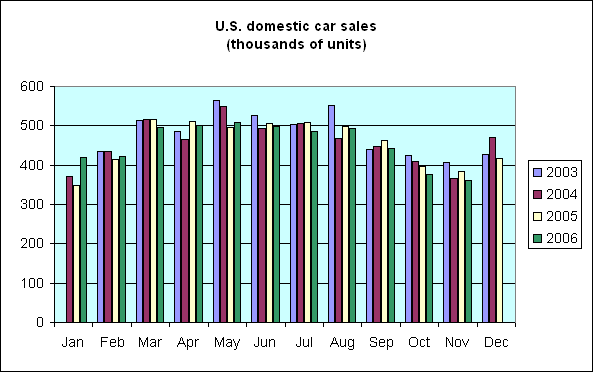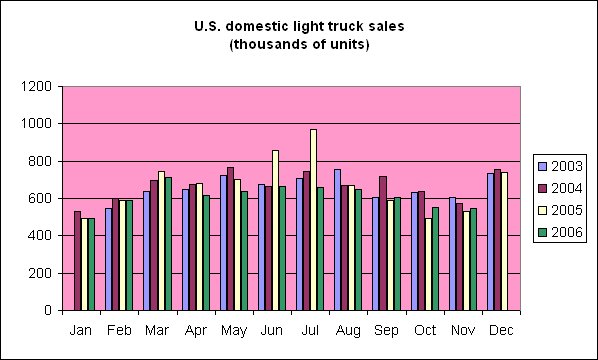November U.S. light vehicle sales were 2.8% higher than last year. Sounds good, until you take a closer look.
 |
For one thing, November 2005 vehicle sales were themselves pretty bad. The downturn in motor vehicles and parts last year was enough all by itself to contribute -1.5% to total 2005:Q4 U.S. GDP growth. October and November 2006 U.S. vehicle sales may be up relative to 2005, but were still below the values for those months in 2004 or 2003.
Moreover, what matters for generating U.S. income and employment is not total sales but rather sales of those vehicles that are manufactured in the U.S. Motor vehicles and parts shed another 20,000 manufacturing jobs in October, and sales of U.S.-manufactured cars for both October and November 2006 were the lowest value of the last three years.
 |
Domestic light truck sales, Detroit’s key money-maker, did improve slightly relative to the very weak 2005 levels. But they’re also substantially down from 2003 and 2004.
 |
All of this would not be that big a deal in terms of the effect on total GDP, if the rest of the economy were doing ok.
That’s a great line. I’m just worried that we seem to have already used it to explain why the housing downturn is not that critical, either.
Technorati Tags: macroeconomics,
autos,
recessions
Thanks for that work with the graphs. And I have little to add –even about the promising outlook for next month (based on and amplified by nice bar illustrations!).
I recall some squawking about GM fleet sales last time (possibly by Ford fans) skewing the data and making GM look so much better than Ford’s $Billion dollar losses. Should we care about ‘light vehicle sales’ including fleet sales?
Should we care about ‘light domestic truck sales’ instead of say ‘luxury vs non-luxury vehicle sales’?
If you had the choice of buying either a car or a house, that is spending dough or making an investment, knowing that the car will certainly be incentivized more deeply later and also knowing that the house will be similarly incentivized, would you spend the small change like buying gum or would you splurge radical, following Bob Toll’s mouth and not his behavior?
Ok, a trick question, seeing as how you’re not going to spend a dime nor invest a splurge. So we wait for the civil unrest?
This is the best analysis that I’ve seen of this important metric. Thanks, Professor.
David Leonhardt’s article in the NYT on housing also got me thinking about an issue that was staring me in the face.
What statistics on home sales aren’t saying
What is staring me in the face? Supply and demand. The supply of homes has been growing. Implication: if demand doesn’t pick up, homes either won’t sell or the seller’s will have to lower prices to the point that demand and supply balance.
On the surface, this is obvious, but it is another consideration to take into account when we’re told that housing prices are stable. This stability in prices sounds great on paper, but try telling that to someone trying to sell their home. Either all the sellers don’t really need to sell their homes, can take them off the market, and demand and supply balance out at existing prices. Or we’re going to see price drops in order to get the market moving again.
Your auto data seems to come from a subscription web site. I would like to know what is domestic and what is not. Is a DaimlerChrysler product assembled in Ontario domestic? Is a Honda built in Central Ohio foreign?
I am not surprised to see total employment drop. The “Big 3” have been subsidising employment for years, so it should be higher than is economic.
The industry is in dire straights due to over-capacity, union contracts and a lot of poor management by the “Big 3.” Several parts suppliers are in Ch. 11 and Ford and GM may follow. The long term prospects are for reduced employment in a restructured and more profitable industry
Robert, your DaimlerChrysler would be counted as an import and the Honda as domestic.
Ok, I’ve had my fill now of the lovely curves showing that summer really is the peak season to be buying a vehicle. Almost.
These stats are not SA like the ones that come with the Commerce Dept issued not too long ago that showed the startling auto contribution to GDP (advance contribution of 0.7 to the 1.6 GDP, preliminary contribution of 0.6 to 2.2 GDP). And I thought I had this all figured out as a reflection of the stressed domestic auto industry clearing out old stock in q3s. And serious bad news coming in q4.
But I don’t see much of this in the data here. Cruel world.
You do write:
which I think might come from the same page I was on talking about quarterly changes, not monthly.
Sadly, the bulgey 3rd quarter sales (that would be July-Sept) I expected due to incentivized sales provoking that miserable q4 showing in 2005, is not so obvious in the monthly data here.
Could it be spencer is right that I am squeezing information out of the data that isn’t there?
Calmo, the -1.5% figure comes from BEA Table 1.5.2. You’re right those BEA numbers are based on seasonally adjusted quarter-to-quarter changes, whereas the numbers I plot here are monthly and seasonally unadjusted. But no matter what numbers you look at, fall 2005 was a bad time for autos, and fall 2006 is not much better.
So there could still be some juice in my lemon (wait till I tell spencer): huge 05q4 drop from previous quarter (~ -20?) illustrating for me (not spencer though who is not easily (mis)led) those brought-forward sales due to incentives to clear out remaining 05 stock in a deteriorating market share for domestics. So here we are again, it seems to me, about to see a real ding in q4 GDP from a continuing lousy auto sector, that has already spent some of its q4 sales last quarter. (Not to mention a housing market that has made many feel less affluent.) And a ding from a not-too-impresive 2.2% GDP not the ~4% it was a year ago.
Ok, that lemon has had it now.
Don’t worry, calmo. What we lack in growth this year we’ll make up in inflation. (Think 8-10% M3 growth. Then think what would have happened if that hadn’t happened.)
Me worry? Hope so! (Can you stand pain?) Could do!
Could be…so Ken, mighty non-worrier, [Geeze I like the sound of that against ‘warrior’] are you an advocate of the Euro-style conception/calculation/idea/thought/view of inflation?
You figure it’s somehow not fair that there are 2 camps here? This B disintermediated by freely traded currencies, yes? And therefore the dollar sinks until those interests rates rise, is that it? And so it seems to my ill-trained little brain that the coming interest rate hikes in the euro are bad news for BB.
But do I worry?
Not terribly.